Figure A.10 Session state and state transition
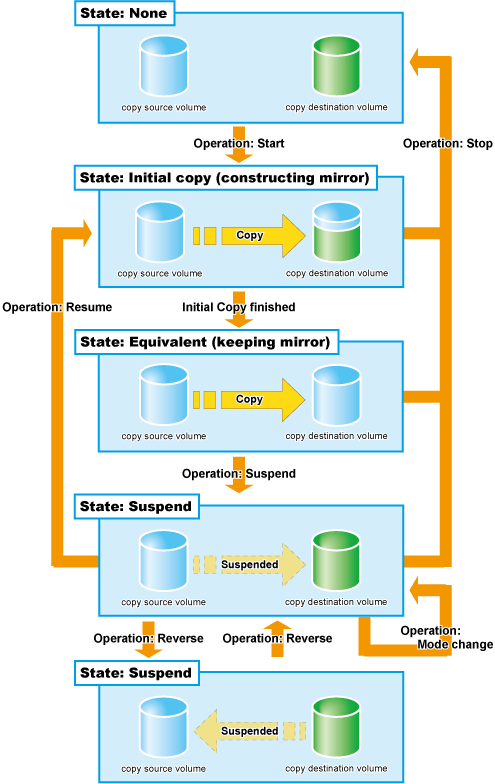
Session operation | Express function |
|---|---|
Start | acec start |
Suspend | acec suspend |
Resume | acec resume |
Reverse | acec reverse |
Mode change | acec change |
Stop | acec cancel |
Start
When the REC session is started, the whole area of data specified by the source parameters is copied.
If data copying has been completed for a given area and a write operation is applied to that area, the write data is also transferred to the destination area.
After all data in the specified area has been copied over, the data in source and destination areas will be kept in almost the same state by the REC function. This is called the Equivalent state. In the Equivalent state, if source data is changed, the same data is transferred to the destination area to maintain the Equivalent state.
Until the REC session reaches to the Equivalent state, copy destination volume are neither readable nor writable. If REC session is in the Equivalent state, copy destination volume are not writable but readable.
Unlike EC, the following operation modes need to be specified at the start of REC sessions.
This mode is concerned with data transmission of REC.
Transmission Mode | Description |
|---|---|
Synchronous mode | The REC Synchronous mode guarantees that the copy process is fully complete on both sides of the REC before any update process response is returned to the server. Since the update and copy processes are performed at the same time, the copy process order will naturally be the same as the update process order. However, the concomitant REC transfer processes will always cause the update responses to be slower than a native update alone. Especially, when the Remote Advanced Copy is used in a long-distance WAN connection, the transmission via the WAN is delayed and the data transmission process is also delayed, which can greatly affect the performance. |
Consistency mode | The sequential transfer of data to destination ETERNUS Disk storage systems is guaranteed in all REC sessions where the Consistency mode has been set. A checkpoint is set at a certain interval (every few seconds) and pending data is copied over during this interval. Synchronous data can be maintained at a certain level. To guarantee the order property, a special REC buffer must be assigned in the cache memory. Before starting the copy session, an REC buffer must be setup in each ETERNUS Disk storage system (both source and destination) to contain pending changes. You cannot simultaneously use a given REC buffer for both transmission and reception. However, the REC buffers can be switched from transmission to reception and back. As the response to the updating process by the server is executed asynchronously with the copy process, delays are minimized. If many data updates are requested, the write-completed response to the server is delayed and the copy process is executed at the higher priority. However, if too many requested changes are pending, the copy processes can cause the server response to become excessively slow, so the copy session is temporarily Halted. After a certain period of time, a prescribed error recovery process is started. In the Consistency mode, the Stop and Suspend sequence is different depending on whether or not Concurrent Suspend is used. |
Stack mode | In the Stack mode, source-side data updates are responded to immediately. The copy process is executed asynchronously so that it does not affect the response to the server. The copy source area for each copy session is regularly patrolled for updates. However, when multiple writes have occurred in the same location, only the current data at the time of the next patrol check needs to be sent to the copy destination, helping to minimize the amount of transfer data. Therefore, this mode allows data copying with no effect on server performance even if the data transfer line bandwidth is limited. The following sequence of Stop and Suspend commands must be executed to guarantee that the potentially large amounts of data that may remain in the buffer are copied to the destination. |
Through mode | Use of this mode is not recommended. The Through mode is still provided for compatibility with legacy systems. However, you should understand how data is copied in the Through mode since it may be useful if the Consistency mode and the Stack mode are stopped for certain reasons. As the response to source-side data updates is executed asynchronously with the copy process, delays are minimized. When data is updated, the copy process is queued. However, the queue has limited length and if the number of queued processes exceeds the limit, the response to the server is delayed and the copy process is executed at the higher priority. Since the queue length is relatively short, the Equivalent state suspend process will always complete within a specified time. Since the data update and transfer processes are executed using the same block size, transmission performance is not high. When writing sequential data in particular, execution of the update and transfer processes is mutually exclusively, so deteriorating performance is a common result. When deciding whether to use this mode, consideration should be given to the fact that processing takes longer to complete than for Stack mode. |
This mode is concerned with how REC sessions behave when the line paths are disconnected by a disaster or line error.
Split Mode | Description |
|---|---|
Automatic Split | If the communication has failed due to certain reasons during REC execution, the REC session is disconnected automatically so that data can be updated at the source location. |
Manual Split | If the communication has failed due to certain reasons during REC execution, the operator is asked whether or not to disconnect the REC session or not in the Manual Split mode. Though the Manual Split mode does reduce availability somewhat, it also helps keep the copy source data and copy destination data better synchronized, resulting in much lower data losses in the event of a disaster. If data copying has failed due to the disconnection of all paths or other reasons, the server becomes unable to update the data in this mode. Therefore, applications that require the data be updated by the server cannot continue if all REC paths become disconnected, or the backup center or backup ETERNUS Disk storage system fails. |
This mode is concerned with how REC sessions are recovered after the line that was disconnected by the transmission error has recovered.
Recovery Mode | Description |
|---|---|
Automatic Recovery | REC sessions are automatically resumed as soon as the line that was disconnected by the transmission error has recovered. |
Manual Recovery | REC sessions must be manually resumed after the line that was disconnected by the transmission error has recovered. |
Suspend
When the REC session is suspended, both the copy source volume and the copy destination volume are accessible as independent volumes (copy destination volume becomes readable and writable). The Suspend operation can only be executed when the REC session is in the Equivalent state.
Unlike the Stop operation, changes to the source and destination volumes continue to be recorded while the Suspend state applies.
The procedure to suspend the REC session varies depending on REC Transmission mode.
In this case, the procedure is the same as that of EC.
Figure A.11 Suspend and resume work flow for REC session in Synchronous mode
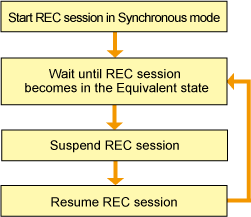
In order to suspend the REC session in these modes, the Transmission mode must be changed to through mode. However, the Transmission mode is not required to be changed if the REC session in Consistency mode is suspended by Concurrent Suspend.
Figure A.12 Suspend and resume work flow for REC session in Stack or Consistency mode
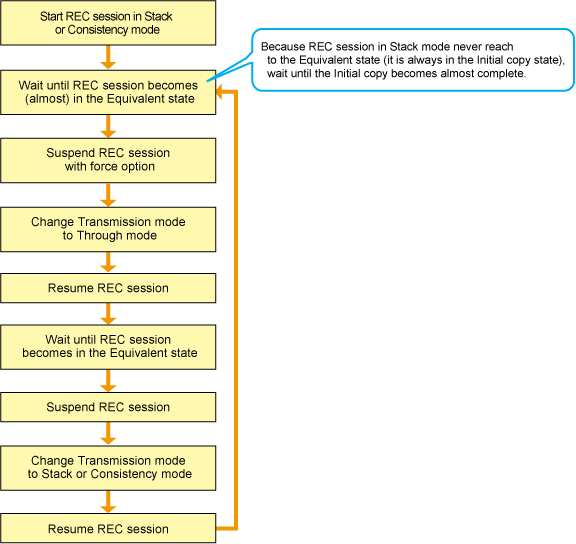
Concurrent Suspend
As EC, multiple REC sessions can be suspended using the Concurrent Suspend operation. This allows consistent copies of multi-volume data-objects, such as databases, to be easily acquired.
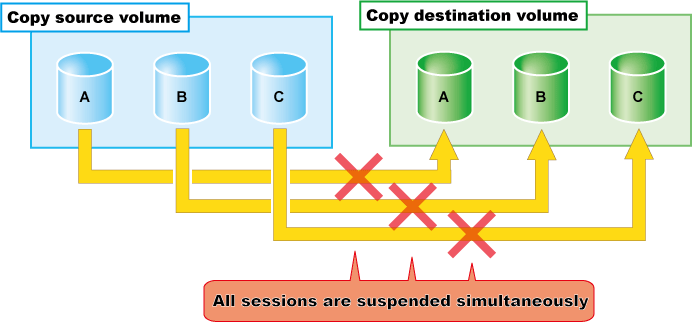
The Concurrent Suspend operation can be performed if the Transmission mode is Synchronous mode or Consistency mode.
Figure A.13 Concurrent Suspend and resume work flow for REC session in Synchronous or Consistency mode
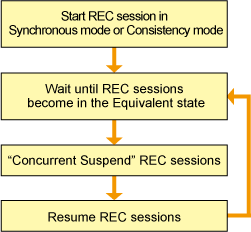
Resume
When the REC session is resumed, data is copied over from the source to the destination so as to catch up on all the changes that were made after the Suspend operation was performed and recover the Equivalent state. As the amount of data that thus needs to be transferred is much less than would be required if the whole source area were to be recopied, the time required to recover the Equivalent state is also greatly reduced.
If the source is changed under the Suspend state (when copying is temporarily interrupted by the Suspend operation), the changes are sent to the destination after the Resume operation is performed (when the copy is restarted). However, any changes made at the destination while under the Suspend state will be rolled-back (overwritten from the source data). Consequently, any and all changes made to the destination during the Suspend state are discarded and lost following the Resume operation.
The operation modes of REC are not changed by the Resume operation.
Reverse
When the REC session is reversed, the copy direction is reversed. The Reverse operation can only be executed when the REC session data is in the Suspend state.
Mode change
When the REC session is in the Suspend state, the operation modes can be changed by the "Mode Change" operation.
Stop
When the REC session is stopped, it terminates. If the REC session in one of the following statuses is stopped, the copy destination volume should not be used because the mirroring is incomplete.
Initial copy state
Error suspend state
Halt state which occurred when the REC session was in the Initial copy state
If the REC session in one of the following statuses is stopped, the copy destination volume can be used because the mirroring has been complete.
Equivalent state
Suspend state
Halt state which occurred when the REC session was in the Equivalent state